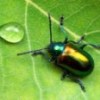They looked like little flowers, or miniature suction cups, but yesterday's mystery was neither. Here's a more recent view:

Arilus cristatus, a newly hatched wheel bug nymph with eggs
Ted MacRae of Beetles in the Bush picks up 6 points for guessing that they were Reduviid eggs, and MarekB gets 4 for nabbing the genus and species. Plus, one point goes to Chris Grinter who surmised that these might be hemipteran eggs.

By late summer this little buglet will have grown into a wheel bug, a massive assassin as large as my thumb:


Hey! That's the weird bug I saw last summer! It was outside our building - just a few miles NorthWest of you in Normal, IL, and a bunch of us were standing around trying to figure out what the heck it was.
I would never guess looking at the nymph that it would grow into the freak that I saw.
Although I figured out the species using the Internet (the fast way), the original thought of a reduviid egg mass stemmed from an earlier browsing through a new and excellent book Tracks and Sign of Insects and Other Invertebrates by Eiseman & Charney. I later checked the chapter on eggs and it turns out that the wheel bug egg mass is portrayed there as well. A really good source for identifying many of the strange structures that the invertebrates produce or tracks they leave behind.
Certainly had me fooled. I was thinking along the same lines as Ted (well.. his initial hunch). Was guessing you had invested in an underwater housing and been visiting somewhere exotic, photographing coral polyps.
Beautiful photos; if only I taught biology rather than physics
Yes, I kind of expected that a guess of an owlet moth was wrong, especially after MarekB brought up the Wheel Bug and I looked at some pictures. But still, somebody has to stick up for the long shots, right?
The polyp guess was half in jest, but then I recalled a college experience rearing some Zelus assassin bugs from an egg mass I found. It didn't look quite like that species, but I did remember the sunken tops of the eggs and their intricate rim structure, so Reduviidae seemed a reasonable guess. I should've been a little more persistent in guessing a species - knowing you're in northern Illinois and your size hint that implied these were a relatively larger species. :)
Oh, ouch. I've been bitten by an adult; that'll probably go down as one of the most traumatic experiences of my life ...
But the little nymphs are so cute! I didn't expect that.